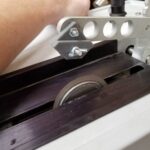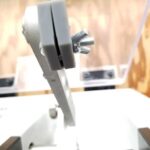This was a fun project with the high-pressure experimental petrology group during my internship at NASA. Another intern and I were challenged as a team to prepare mounted thick sections of lunar and Martian analogs they synthesized so that they could be used for nano-SIMS analysis. We were tasked to prepare about 120 of these samples. For most analytical geochemistry purposes, samples can be prepped, mounted, and polished using epoxy resin as a base. However, it’s not as easy with nano-SIMS because hydrocarbons and other volatiles present within the epoxy will degas while within the instrument, consequently ruining the measurement. So, we needed to come up with an alternate solution. Further complicating the matter, these samples were encased within an outer shell, the entirety of which was only slightly thicker than a paperclip.
The mineral surface needed to be exposed for nano-SIMS analysis and we were under strict orders to preserve as much of the sample as possible, as they could not be replaced. That meant we couldn’t simply grind away half of the sample to reveal the mineral surface. We would need to cut something about as thick as a headphone jack in half while preserving as much of the sample inside as possible.
Eventually, we found a saw blade thin enough to be able to cut through the sample that could be used with a precision-grade rock saw we had available in the sample prep lab. However, the sample holder for this saw was far too large to hold the sample steady while cutting. We enlisted the aid of Thomas Cowden, an engineer at NASA within the ARES division, and began researching possible solutions. By measuring the dimensions of the sample capsules, we decided the best thing to do was to 3D print a new sample holder for the saw that would fit the small size of the capsules. Traditional PLA thermoplastics used in 3D printing would not suit our purpose, as they did not conform to the degree of precision we needed to maintain for such small samples. Therefore, we opted to use UV resin-based printing technologies to form the sample holder device.
Thomas helped us design the sample holder using auto-cad and, after successfully printing the prototype, we were able to complete the assigned task to the surprise of our supervisors. This was a great success and a testament to the value of putting our heads together as a team in order to solve complex problems.



